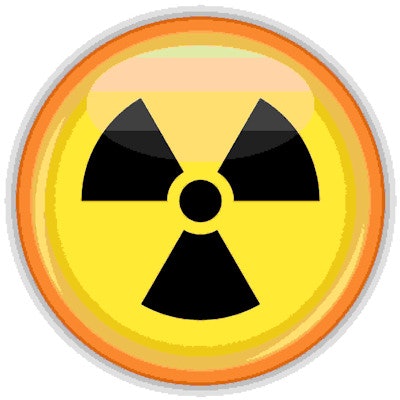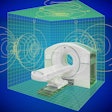
A large, five-year Dutch-led study has found the probability of receiving a high radiation dose from CT is small but not negligible, highlighting the risk of dose-related cancer and the need for radiation tracking. In an article posted on 18 January by BMJ Open, 80% of patients receiving a high effective dose had an initial oncology-related CT scan.
"In a time where use of CT imaging continues to increase, awareness of the cumulative radiation exposure and the accompanying potential health risk, in particular for younger patients, may lead to more careful and deliberate consideration and justified use of CT examinations," noted Dr. Cécile Jeukens from the department of radiology and nuclear medicine, Maastricht University Medical Center, and colleagues.
The primary outcome was the probability of receiving a high effective dose, defined as ≥ 100 mSv, from one or more CT exams as derived from a time-to-event analysis. Secondary outcomes were the clinical indication for the initial scan of patients receiving a high effective dose.
The researchers studied a total of 100,672 CT examinations (46,710 CT in women and 53,962 in men) performed on 49,978 patients (23,918 women and 26,060 men). Of these patients, 482 (1%) received a high cumulative radiation dose. For high-dose patients the median age was 63 years (range, 20-89), and the majority (52.9%) received 6-10 CT examinations during the study period. The median follow-up period of high-dose patients was 4.2 years (range, 12 days to 6.5 years).
The team then estimated the probability of a high effective dose from a single examination as low -- only one patient received a high effective dose during a single CT exam (0.002% [95% confidence interval (CI), 0.00%-0.01%]). Probability differed in line with gender, age, and number of CT exams received. The 4.5-year probability of receiving a high cumulative effective dose was 1.9% (95% CI, 1.6%-2.2%) for women and 1.5% (95% CI, 1.3%-1.7%) for men.
| Probability of receiving a high radiation dose in 5 years by gender | |
| Men | 1.5% |
| Women | 1.9% |
| Probability of receiving a high radiation dose in 5 years by age | |
| Under 18 years | 0% |
| 18-50 years | 1.1% |
| 50-64 years | 2.5% |
| 65-74 years | 2.4% |
| Probability of receiving a high radiation dose in 5 years by number of CTs received | |
| 1-2 | 0.01% |
| 4 | 2% |
| 5 | 4% |
| 6-10 | 16% |
| 11 or more | 32% |
The 4.5-year probability of receiving a high cumulative effective dose was highest in the age range categories of 51 to 74 years -- at 2.5% for ages 51-64 (95% CI, 2.1%-2.9%), 2.4% for ages 65-74 (95% CI, 2%- 2.9%), 1.1% for ages 18-50 (95% CI, 0.9%-1.4%; p ≤ 0.05), and 0% for those over 18.
Furthermore, it was 0.01% for patients who underwent 1-2 CT examinations (95% CI 0.00%-0.03%); 16% for patients with 6-10 CT examinations (95% CI, 14%-18%); and 32% for patients with 11 or more CT examinations (95% CI 26%-39%). Nearly 40% of patients received multiple CT examinations, and almost all high-dose-receiving patients underwent more than one CT examination.
Among patients who received a high effective dose, most indications (80%) were oncology related.
| Clinical indication in high-dose patients | |
| Cancer | 384 (79.7%) |
| Abdominal nonmalignancy | 39 (8.1%) |
| Vascular disease | 37 (7.7%) |
| High-energy trauma | 9 (1.9%) |
| Other (Failed surgery, Interstitial lung disease | 13 (2.7%) |
| Baseline characteristics of patients receiving high dose | |
| Category | No. (%) |
| Sex | |
| Women | 256 (53.1) |
| Men | 226 (46.9) |
| Age (years) | |
| < 18 | 0 (0) |
| 18-50 | 88 (18.3) |
| 51-64 | 194 (40.2) |
| 65-74 | 154 (32) |
| ≥ 75 | 46 (9.5) |
| Number of CT examinations | |
| 1-2 | 2 (0.4) |
| 3 | 6 (1.2) |
| 4 | 19 (3.9) |
| 5 | 29 (6) |
| 6-10 | 255 (52.9) |
| ≥ 11 | 171 (35.5) |
While wide epidemiological data suggests that effective doses in the range of 10-50 mSv are carcinogenic, other organizations claim that cancer risks are small or nonexistent with exposure levels below 100 mSv. However, effective doses of 100 mSv and above are consistently considered carcinogenic, according to the authors.
In practice, while effective dose reduction has been possible over time, imagers have opted for higher effective doses for improved image quality. Furthermore, patients are often imaged repeatedly over time and may be receiving a high cumulative effective dose from multiple CT examinations, they continued.
The authors found little information about the percentage of patients undergoing CT examinations who accumulate high effective doses from recurrent CT examinations and clinical settings in which patients are likely to receive such high effective dose, and they point to a wide incidence range of patients receiving high cumulative effective doses -- from 0% to 15%, depending on study design and follow-up period -- in the existing literature.
While for some oncology patients with shortened life expectancy cumulative effective doses may be considered of less importance, patients who receive high effective doses (> 100 mSv) for nonmalignant diagnoses may be relatively young, Jeukens and colleagues noted.
"These findings support tracking radiation dose on an individual level. Patient radiation tracking might hypothetically lead to increased dose awareness among radiologists and referring physicians," they stated.



















